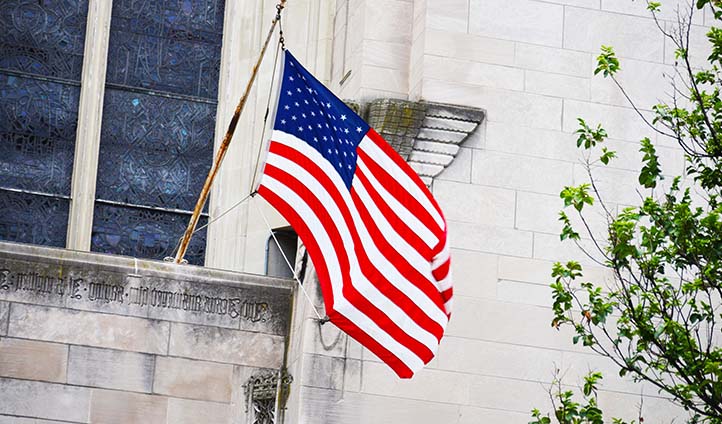SCOTUS Hears Final Oral Arguments of Term

The U.S. Supreme Court is winding up the current term, with oral arguments held in the final six cases this week. The issues before the justices, many of which resulted in lively oral arguments, included the appointment of administrative law judges, immigrant removal, and redistricting. President Donald Trump’s travel ban also returned to the Court.
Below is a brief summary of the specific issues before the Court:
Lucia v. Securities and Exchange Commission: In one of the most significant administrative law cases of the term, the justices must address the validity of the appointment of administrative law judges of the Securities and Exchange Commission (SEC). The Appointments Clause of the U.S. Constitution mandates that all “officers” of the United States be appointed by the president, by the “courts of law,” or by the “heads of departments.” The specific question before the Court is “whether administrative law judges of the Securities and Exchange Commission are Officers of the United States within the meaning of the Appointments Clause.”
Pereira v. Sessions: The immigration case focuses on how to interpret the federal removal statute. The Attorney General is authorized to cancel the removal of certain immigrants under 8 U.S.C. § 1229b (a) and (b). To be eligible for cancellation of removal, a non-permanent resident must have ten years of continuous presence in the United States, and a permanent resident must have seven years of continuous residence. Under the “stop-time rule,” those periods end when the government serves a “notice to appear under section 1229(a) of this title.” Section 1229(a) defines a “notice to appear” as “written notice … specifying” certain information, including “[t]he time and place at which the proceedings will be held.” The justices have been asked to resolve a circuit split regarding whether, to trigger the stop-time rule by serving a “notice to appear,” the government must “specify” the items listed in the definition of a “notice to appear,” including “[t]he time and place at which the proceedings will be held.”
Chavez-Meza v. United States: The criminal case should resolve a circuit split over how detailed courts must be when discussing sentencing modifications in their opinions. The specific question is before the Court: “Whether, when a district court decides not to grant a proportional sentence reduction under 18 U.S.C. § 3582(c)(2), it must provide some explanation for its decision when the reasons are not otherwise apparent from the record, as the U.S. Courts of Appeals for the 6th, 8th, 9th and 11th Circuits have held, or whether it can issue its decision without any explanation so long as it is issued on a preprinted form order containing the boilerplate language providing that the court has ‘tak[en] into account the policy statement set forth in 18 U.S.S.G. § 1B1.10 and the sentencing factors set forth in 18 U.S.C. § 3553(a), to the extent that they are applicable,’ as the U.S. Courts of Appeals for the 4th, 5th and 10th Circuits have held.”
Abbott v. Perez: The term’s final redistricting case comes out of the State of Texas and involves both its congressional and state legislative districts. The Court must first decide the following: (1) Whether the district court issued an appealable interlocutory injunction when it invalidated Texas’ duly enacted redistricting plan and ordered the parties to appear at a remedial hearing to redraw state congressional districts unless the governor called a special legislative session to redraw the congressional map within three days; (2) whether the Texas legislature acted with an unlawful purpose when it enacted a redistricting plan originally imposed by the district court to remedy any potential constitutional and statutory defects in a prior legislative plan that was repealed without ever having taken effect; (3) whether the Texas legislature engaged in intentional vote dilution when it adopted Congressional District 27 in 2013 after the district court found, in 2012, that CD27 did not support a plausible claim of racially discriminatory purpose and did not dilute Hispanic voting strength because it was not possible to create an additional Hispanic opportunity district in the region; and (4) whether the Texas legislature engaged in racial gerrymandering in Congressional District 35 when it simply adopted the district unchanged as part of the court-ordered remedial plan.
Animal Science Products, Inc. v. Hebei Welcome Pharmaceutical Co. Ltd.: The case involves when U.S. courts must give deference to their foreign counterparts. The specific issue before the justices is “[w]hether a court may exercise independent review of an appearing foreign sovereign’s interpretation of its domestic law (as held by the U.S. Courts of Appeals for the 5th, 6th, 7th, 11th and District of Columbia Circuits), or whether a court is ‘bound to defer’ to a foreign government’s legal statement, as a matter of international comity, whenever the foreign government appears before the court (as held by the opinion below in accord with the U.S. Court of Appeals for the 9th Circuit).
Trump v. Hawaii: In the latest iteration of the travel ban challenge, the justices have agreed to consider the following issues: (1) Whether the respondents’ challenge to the president’s suspension of entry of aliens abroad is justiciable; (2) whether the proclamation – which suspends entry, subject to exceptions and case-by-case waivers, of certain categories of aliens abroad from eight countries that do not share adequate information with the United States or that present other risk factors – is a lawful exercise of the president’s authority to suspend entry of aliens abroad; (3) whether the global injunction barring enforcement of the proclamation’s entry suspensions worldwide, except as to nationals of two countries and as to persons without a credible claim of a bona fide relationship with a person or entity in the United States, is impermissibly overbroad; and (4) whether the proclamation violates the establishment clause of the Constitution.
Previous Articles
Key Cases to Watch During the Supreme Court’s November Sitting
by DONALD SCARINCI on November 5, 2025
The U.S. Supreme Court’s November sitting begins on November 3 and concludes on November 12, 2025...
SCOTUS Clears Way to Terminate Protected Status for Venezuelan Nationals
by DONALD SCARINCI on October 29, 2025
On October 3, 2025, the U.S. Supreme Court granted an emergency request from the Trump Administrati...
Supreme Court Cases to Watch in the October Sitting
by DONALD SCARINCI on October 23, 2025
The U.S. Supreme Court’s new term, which began on October 6, has the potential to be historic. In...
The Amendments
-
Amendment1
- Establishment ClauseFree Exercise Clause
- Freedom of Speech
- Freedoms of Press
- Freedom of Assembly, and Petitition
-
Amendment2
- The Right to Bear Arms
-
Amendment4
- Unreasonable Searches and Seizures
-
Amendment5
- Due Process
- Eminent Domain
- Rights of Criminal Defendants
Preamble to the Bill of Rights
Congress of the United States begun and held at the City of New-York, on Wednesday the fourth of March, one thousand seven hundred and eighty nine.
THE Conventions of a number of the States, having at the time of their adopting the Constitution, expressed a desire, in order to prevent misconstruction or abuse of its powers, that further declaratory and restrictive clauses should be added: And as extending the ground of public confidence in the Government, will best ensure the beneficent ends of its institution.





